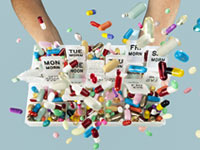Staying Fit
The symptoms were sudden and severe: tightness in the chest, dizziness, nausea. "I thought I was having a heart attack," says Lynn Golden, a 59-year-old retired scientist living in Maryland. Rushed to the emergency room, she spent two days in the hospital having exhaustive tests that all proved negative. It was only later that she discovered the cause — unexpected side effects from a prescription drug she'd started taking three weeks earlier to manage a mild thyroid condition.


Golden's experience is a classic example of how medications can cause other conditions unrelated to the health problems they're prescribed to treat. Unaware of this, patients very often consult their doctors about this "new" condition — only to be prescribed yet another drug that could produce still more side effects.


AARP Membership— $12 for your first year when you sign up for Automatic Renewal
Get instant access to members-only products and hundreds of discounts, a free second membership, and a subscription to AARP the Magazine.
This syndrome is known as a drug "cascade." It's not as well studied as more dramatic problems with prescription drugs — such as when apparently safe drugs turn out to be deadly — but it is of growing concern. Experts estimate that tens of millions of people are suffering every day — often without knowing why. "There are a lot of people taking drugs to treat the side effects of drugs," says Gordon Schiff, M.D., an internist on the faculty of Harvard Medical School and associate director of the Brigham Center for Patient Safety Research and Practice in Boston. "And sometimes that makes sense, and maybe the initial drug is essential. But when you're taking a drug to treat the side effect of a drug which is treating the side effect of another drug, it gets to be rather a house of cards."
Adverse drug effects send about 4.5 million Americans to the doctor's office or the emergency room each year — more than for common conditions like strep throat or pneumonia — according to a recent study by the federal Agency for Healthcare Research and Quality. The National Academy of Sciences' Institute of Medicine estimates that serious drug reactions occur more than 2 million times each year among patients in hospitals and are the fourth leading cause of hospital deaths, topped only by heart disease, cancer and stroke.
But the fatal or serious reactions most often reported are only the tip of the iceberg, experts say. "There are tens of millions of milder reactions, some of which are quite damaging to people even though they're medically regarded as minor," says Donald W. Light, a medical sociologist and editor of The Risks of Prescription Drugs, a book that reviews current evidence of medication problems.
Milder symptoms such as drowsiness, sleeplessness, muscle aches, dizziness, nausea and bouts of depression may be more troubling than they are dangerous. Yet, Light says, studies show drugs that affect people's sense of balance or slow their reactions are a major cause of falls and road accidents. Even gastric problems or muscle pain can seriously affect mobility and mood, hampering work, activities and family relationships.
Why do drugs prescribed for a specific health problem trigger other health problems? Errors made by doctors, pharmacists, hospitals — and patients themselves — are a major problem. But even if all errors were avoided, knotty issues remain, including bad interactions among different drugs prescribed for the same patient by different doctors; drugs prescribed for uses that the Food and Drug Administration has not approved; and an imperfect testing system for new drugs, which permits the marketing of medications that only later prove to have harmful side effects.

































































More From AARP
Do Drugs for Early-Stage Alzheimer's Work?
Or do the risks outweigh the benefits?